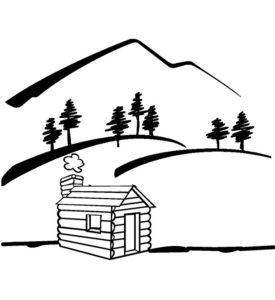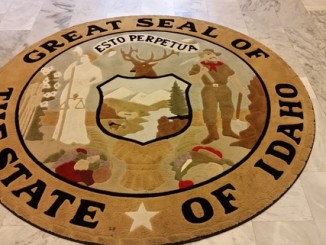Biodiversity and Ecosystems
After gathering wood in the forest for a warm fire, my father insisted that we not only clean up our mess, but clean up other slash and debris in the area. I did not understand at the time he was teaching us how to take care of the land in Island Park. Another dreaded chore was cutting down tall, overgrown grass around the cabin during the hot August summers. He knew this was a fire load that could potentially fuel a major fire. But we also went on our special trip for huckleberries. No habitat was destroyed, the vegetation is still there, and the huckleberries still grow. Daddy, thank you for teaching me how to care for and respect the land in Island Park.
One component is biodiversity. It is defined as “diversity among and within plant and animal species in an environment.” Island Park has a multitude of different species which we all love such as wild strawberries, morels, watercress, trees, rainbows, brookies, skunks, porcupines, and the beloved moose and elk. From all indications, each continues to survive in Island Park.
Wetlands are “land that has a wet and spongy soil, as a marsh, swamp, or bog.” Island Park has the most beautiful marsh behind Elk Creek. In spite of weekly horseback riding through that marsh there was no long term damage. The marsh still exists.
Riparian refers to the bank of a river or lake and anything living around it such as fish, other water species, and vegetation. Elk and other animal species use it for water and food. We use it to cast a fly for fish that might take a bite or jumping in for a swim, or maybe just look for a pretty rock.
Wildlife, biodiversity, wetlands, and riparian areas are just a few ecosystem components. They are interconnected, dependent on each other for survival, and terms used by NGOs and government agencies to justify their work. Humans are one component not always mentioned. Not seen as a necessary presence in the ecosystem, humans are more often than not considered a destructive force, requiring removal for ecosystem protection. Conservation and removing all human activity are scientists and NGO goals.
There is grave concern that land development is encroaching upon buffer zones, areas that surround a protected area which are intended to shield the core area from man’s activities, thus allowing more space for mammals. Private land ownership is in a precarious position. There are ongoing discussions about controlling land use planning from regional to municipal levels. Seen as part of “ecosystem management”, land use planning objectives include conservation, stopping development, zoning and growth controls, and increasing restrictions. How you design your home and land will be dictated to you. This article by ScienceDirect explains it beautifully.
Land, plant, and animal species don’t understand boundaries, extending themselves across states, into designated parks such as West Yellowstone, and even across countries. Ecosystems are viewed in the same manner, there are no jurisdictional boundaries. NGOs such as The Nature Conservancy (TNC), believe these ecosystems, components and corridors, have the right to protection regardless of jurisdictional boundaries. These boundary erasures create a regional concept, erasing boundaries between states and counties, the United States and other countries, and create an artificial “conservation boundary”.
Essentially, the United States is being divided up into regions with artificial boundaries made up of different conservation areas. Here is a map of “conservation planning boundaries” from the Wildlands Network, which includes the current agenda in Island Park, Yellowstone to Yukon and Crown of the Continent.
Part of the proposed US 20 IP Corridor Plan is the placement of artificial overpasses for safer passage during Elk migration, just a first step towards creating artificial corridors for connectivity. Each ecosystem component will be gradually introduced for protection, such as riparian areas.
Riparian areas extend into surrounding wetlands and other water sources which will extend boundaries further for conservation. Ecosystem components will eventually be used to place the whole environment into some type of corridor needing protection, either through conservation or designation as a protected site. Remember, your private property will be impacted by this.
All of this falls under the Climate change umbrella. According to NGOs drastic action must be taken to not only conserve areas and protect them from humans, “mitigation” measures must be undertaken to prevent loss from development and climate change. The essence of mitigation is to avoid, minimize, and offset environmental impacts to lands and waters.
In 2016 the US Fish and Wildlife Service released their new Mitigation Policy. This policy provides a framework and landscape-scale approach for mitigation with increasing conservation, no net loss of resources or values, and effective linkage for landscape scale conservation strategies. Created by the United Nations Environment Program (UNEP), the International Panel on Climate Change (IPCC) always uses science endorsing climate change. However, there is science that does not support the idea of climate change, or even if it exists. According to the International Climate Science Coalition (ICSC) there are opposing scientific views. Even the former Director of Greenpeace, Dr. Patrick Moore, now has doubts.
As ecological engineers, scientists believe in giving “point value” to everything, a mathematical formula. Although the Island Park NGO conservation agenda has not yet advanced to creating corridors for other components, the same value points will be assigned to them. An example of this can be found in the Cramer Safety Solutions report used in the US 20 IP Corridor Plan, starting on page 159. For some reason land ownership and recreation receive low point value.
The environment is remarkably skilled at regenerating itself. Our only job is using it and helping it when needed, like cleaning up the floor bed to reduce fuel loads. It is interesting that such a dichotomy exists with NGOs. On one hand their agenda is leaving the environment in its natural state. At the same time they are creating environmental engineering schemes to alter it.
 Use of this land, from the time my father was a teenager to present, did not cause any permanent damage requiring protection. Yet the future generation from that era, the current generation, is denied the right to use and enjoy this land as he did, with efforts underway to completely end all use. There is nothing that justifies this. The current wildlife passage project has nothing to do with Elk.
Use of this land, from the time my father was a teenager to present, did not cause any permanent damage requiring protection. Yet the future generation from that era, the current generation, is denied the right to use and enjoy this land as he did, with efforts underway to completely end all use. There is nothing that justifies this. The current wildlife passage project has nothing to do with Elk.
This is a systematic agenda to alter where and how we live, and erase sovereign boundaries. It is part of a broader agenda to destroy state sovereignty and our foundation of government upon which America was built.
My bond with Island Park grew from touching her land, hearing her sounds, seeing her beauty, tasting her gifts, and caring for her. Isolation from humans and landscape alteration are heartless and inhumane agendas, advanced by those who have no bond with her.
To all those NGOs and scientists, we have been, and still are, the custodian, guardian, and protector of Island Park and her gifts, way before you were born or formed into little special interest groups, this was not invented by you, and we care for it more responsibly. There has been no long term damage to Island Park from those who have lived here for generations, there is nothing broke that needs fixed. The most comprehensive and destructive land polices were only born when NGOs became involved. Ask any rancher or farmer, they know.
The true agenda is pushing us off our land into cities, taking control of our resources, and dictating how, if at all, we can use what is rightfully ours. Island Park is our heritage, our ancestry, we are a native and indigenous people, and we will defend her. There is no bond between you and Island Park such as mine.
Part 3 will discuss corridors.





